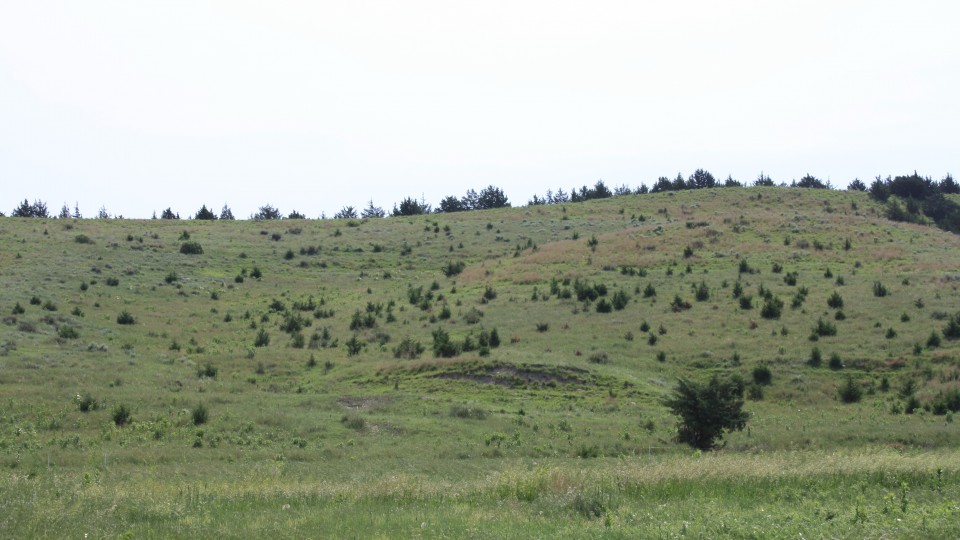Between 1999 and 2018 alone, tree cover increased across 44 million acres of the Great Plains.
One hundred and fifty years ago on Thursday, the novelist Willa Cather was born in her grandmother’s house in Virginia. Though she drew from her Southern childhood throughout her career, plucking memories like grapes from the vine, it was the swelling prairies of Nebraska — surreal in their expanse, in their commune with the sky, in the almost tidal energy underfoot — that conjured her most enduring works, the bluestem eternal that proved her muse.
“The homesteads were few and far apart; here and there a windmill gaunt against the sky, a sod house crouching in a hollow,” she wrote in “O Pioneers!,” the first in her prairie trilogy. “But the great fact was the land itself, which seemed to overwhelm the little beginnings of human society that struggled in its somber wastes.”
Like so many other certainties of the 20th century, however — American hegemony, ground water, Social Security, fossil fuels — Cather’s “great fact” is now in question. North America has already destroyed more than 60 percent of its native prairie. We’ve plowed the sod, left the topsoil to blow away, traded wildflowers for row crops, switch grass for suburbs, hay meadows for Home Depots. We’ve cleaved it apart with freeways, transmission lines, irrigation canals and oil pipelines. And now the Eastern redcedar tree is hungry for what’s left.
Thanks in part to roughly 100 years of fire suppression on the Great Plains, this drought-tolerant native tree — once primarily confined to river bottoms and rocky outcrops — has crept from the gullies to the grasslands, from the humid East to the arid West from Texas to South Dakota, and is now dismantling what little remains of one of the most endangered ecosystems in the world.
As both a journalist and native Nebraskan, I’ve witnessed this “Green Glacier” firsthand. I’ve watched the feathered hills of my childhood on the edge of the Sandhills — still the most intact temperate grassland on earth — turn black with cedar, slowly, in the beginning, then all at once. I’ve hiked through miles of redcedar woodland, the understory drowned in needles: silent, dead and dark. I’ve interviewed ranchers forced to cull their herds for lack of forage, fire marshals recounting uncontrollable flames and environmentalists mourning missing songbirds.
Between 1999 and 2018 alone, tree cover increased across 44 million acres of the Great Plains. Imagine the entire state of Oklahoma, from the Panhandle to the Ozarks, strangled in cedar. Picture so many prairie chickens dancing. Now picture them gone. The bobolinks, too. And the meadowlarks. And many other grassland species, avian and beyond, that have evolved over thousands of years not just to survive, but to rely on the open country. The black-footed ferret. The American burying beetle. And, of course, the grass itself: the side-oats grama, the big and little bluestem that bewildered the novelist in its galloping abundance.
“Except for some of the people who lived in it, I think no one had ever found Nebraska beautiful until Willa Cather wrote about it,” wrote Edith Lewis, her longtime editor and partner. Of course, what Cather eulogized as “wild grazing land” was already a largely a human landscape, a canvas painted by hundreds of generations of Native Americans with fire.
Still, it was hardly a subdivision. And for so many of us who feel similarly awed by the prairie — who have watched the wind approach like a freight train on a cloudless day, rippling water and rustling leaves and finally parting the grass at your feet; who have heard a chorus of coyotes beneath a blanket of stars; who stare at the ocean and remember the grass — there’s a certain truth to her partner’s claim. Many have detailed the human history of the landscape, others the broader ecology. But Cather captured the music in between: that symphony, at once melancholy and free, terrifying and strange, that swells within us, like the land itself, when we are confronted by the horizon unbroken.
“Between that earth and that sky I felt erased, blotted out,” says Jim Burden, the narrator of Cather’s “My Ántonia.” “I did not say my prayers that night: here, I felt, what would be would be.”
Ironically, Cather’s romantic vision, no matter how gripping, was rooted in the same settler-colonial mindset that ushered forth the Green Glacier. Ultimately, both were acts of erasure. For a host of ingenious reasons, Native people had long set fire to the prairie: to rejuvenate vegetation and attract bison herds, to ward off mosquitoes and snakes, to ease travel, even to hinder their enemies in battle. Intentionally or not, they were also keeping the Eastern redcedar at bay, confining the scrappy conifer to the prairie’s deepest wrinkles.
But white settlers were slow to catch on. Confronted by fire, wild or not, they fought back, desperate to save their homes, their crops, their livestock, their culture at large. At the same time, they planted trees in a land without: for shelter, for timber, for shade, for a touch of their forested homelands back east.
“Trees were so rare in that country, and they had to make such a hard fight to grow, that we used to feel anxious about them, and visit them as if they were persons,” Cather wrote. “It must have been the scarcity of detail in that tawny landscape that made detail so precious.”
The federal government encouraged this practice from the start. The Timber Culture Act passed in 1873, permitted homesteaders to claim an additional 160 acres of free land by planting trees on at least a quarter of it. Decades later, desperate to curb the Dust Bowl, President Franklin Roosevelt channeled roughly $14 million — mostly via emergency relief and the Works Progress Administration — to the Prairie States Forestry Project, resulting in nearly 19,000 miles of windbreaks throughout the Great Plains, many of them composed of Eastern redcedar.
Still today, the Department of Agriculture subsidizes the planting of redcedar for everything from windbreaks to wildlife habitat. State programs provide similar cost-share programs, and it’s from all of these plantings (and more) the spread — or the “encroachment,” as ecologists call it — generally begins.
In 2018, the rangeland ecologist Dirac Twidwell and his colleagues at the University of Nebraska began the Eastern Redcedar Science Literacy Project to catalog the fallout. According to one study, Eastern redcedar can transform a thriving tallgrass prairie into a closed canopy woodland in just 40 years. In the process, critical biodiversity is evicted from the landscape. The majority of grassland bird species are no longer present where Eastern redcedar cover exceeds just 10 percent of land cover. Beyond 30 percent, most small mammals vanish, too. And as too many ranchers and other land managers can now attest, both forage production and plant diversity take a nosedive in the Green Glacier’s wake.
Allergies. Wildfires. Tick-borne disease. All of these problems climb while stream flow and groundwater recharge rates often decline. True, a juniper woodland sequesters more carbon. But the grassland it muscled out was a more reliable carbon sink, storing more than 90 percent of its capture underground, safe from wildfires that would send that carbon into the atmosphere. From virtually every angle — environmental or economic, livestock or literature, air quality or landscape aesthetics — the Green Glacier is a problem.
“The Great Plains biome is dying,” Dr. Twidwell said. “Losing grasslands at this scale is akin to losing tropical rainforests or coral reefs.”
And yet, for decades now, discussion about the Green Glacier has been largely relegated to the dusty confines of trade journals and agricultural conventions. Perhaps this is because the vast majority of our remaining grasslands are privately owned. Perhaps, as our forests burn and our levees break, there is little sympathy left for the livestock industry, responsible for roughly 15 percent of the world’s greenhouse gas emissions — never mind the many effects of tree encroachment that bleed far beyond the ranch. Or perhaps, as one of Cather’s New York critics once said, or so she claimed, “I simply don’t care a damn what happens in Nebraska, no matter who writes about it.”
If America wants to preserve what’s left of Cather’s spiritual homeland, something greater than what Dr. Twidwell calls “postage-stamp prairies,” then “the clock is ticking,” he said. The good news is that prescribed fire, where done repeatedly, has proved to effectively halt the Green Glacier’s spread. In fact, the Loess Canyons Rangeland Alliance, a group of neighboring landowners in southwestern Nebraska, is one of the first documented groups to halt the encroachment on a regional scale.
And yet far too many landowners refuse to burn, paralyzed by memories of wildfire, afraid of the liabilities attached to setting their pastures ablaze. While the Agriculture Department’s Natural Resources Conservation Service in 2021 released its first-ever biome-scale “framework” to protect the Plains’ remaining grasslands, what it calls “the world’s most imperiled and least conserved ecosystem,” it is a far cry from the sort of top-down federal efforts to convert prairie to forest that led us here, however unwittingly. The framework, based on the latest science by Dr. Twidwell and other rangeland ecologists, aims primarily to defend and expand the “grassland cores” through prescribed fire and other practices partly subsidized by the federal government and others. In the end, however, these efforts rely on private landowners’ willingness to adopt them.
Not long ago, while reporting on the invasion, I buried myself in bluestem at the Willa Cather Memorial Prairie, just south of Red Cloud, Neb., where the novelist spent most of her childhood. At just 612 acres, it is a postage stamp, to be sure. Still, it has never been plowed and looks much the way it did when Cather lived here — not by the grace of God, mind you, or the spirit of Cather. The grass billows and the prairie swells because the Willa Cather Foundation sets it ablaze when circumstance allows. Since 2006, the foundation has removed approximately 10,000 invasive trees, many of them Eastern redcedar, via cutting and prescribed burns.
But for a moment, I set all that aside. I watched the grass hum, so many stalks buff and bending in the February wind. I watched the clouds feather and flow. Like Jim Burden in “My Ántonia,” I was, for a moment, “entirely happy.”
“Perhaps we feel like that when we die and become part of something entire,” Cather wrote, “whether it is sun and air, or goodness and knowledge. At any rate, that is happiness; to be dissolved into something complete and great.”
The post A ‘Green Glacier’ Is Dismantling the Great Plains appeared first on New York Times.













